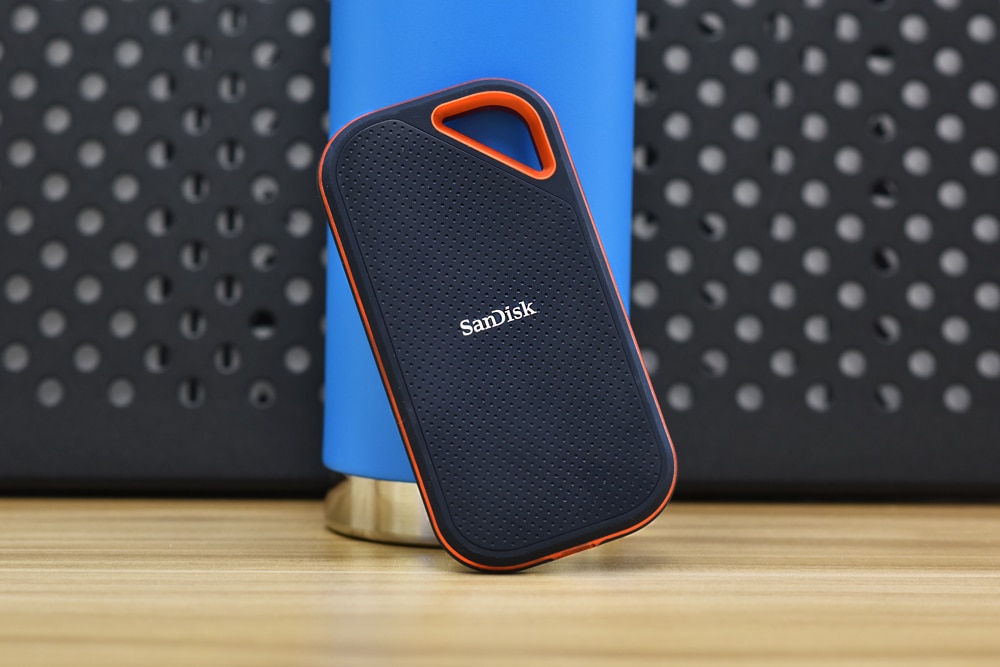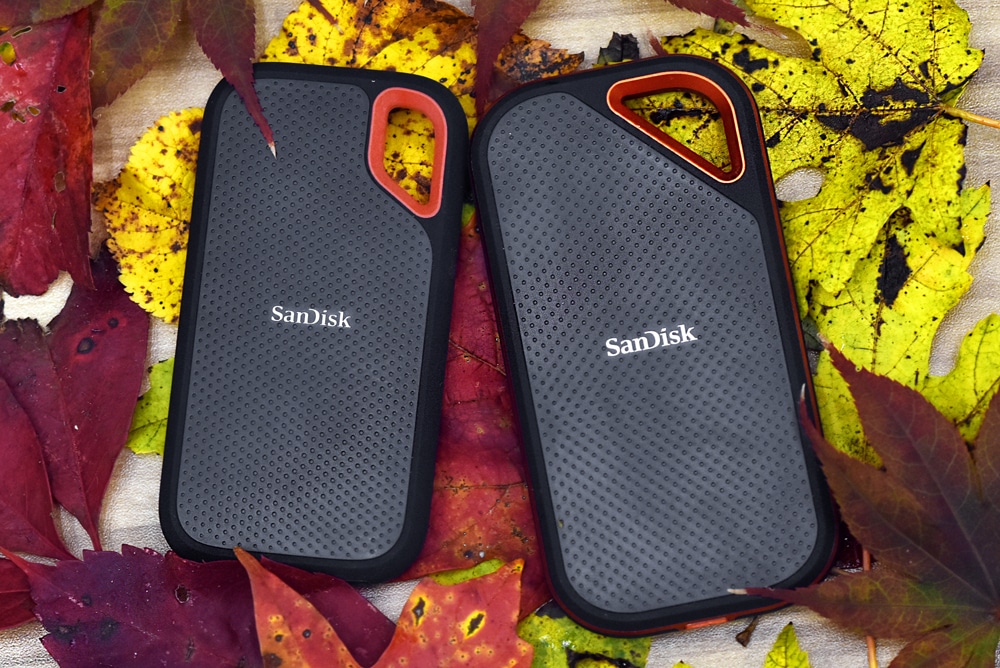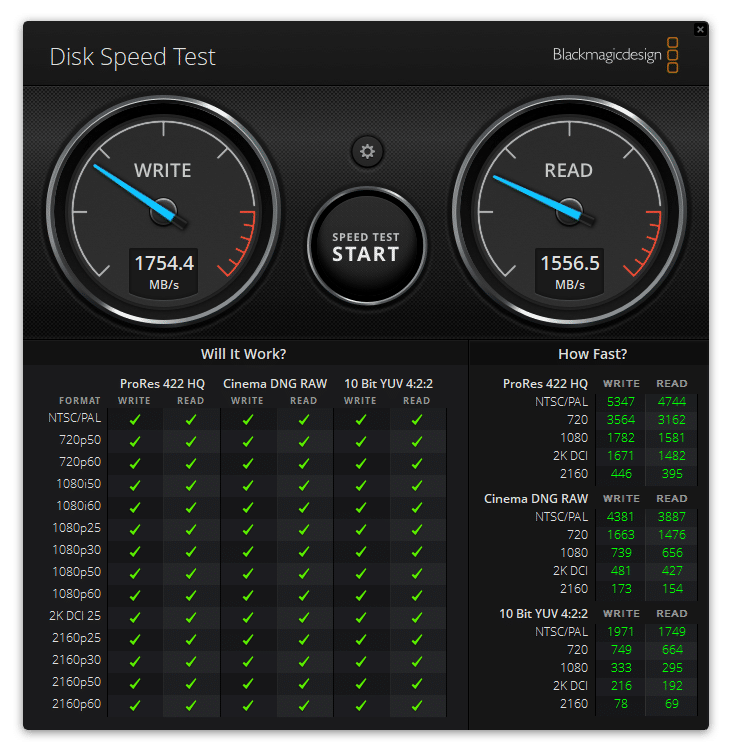The SanDisk Extreme Pro Portable SSD V2 is the premium model of the updated performance-driven line, offering twice the speeds of the non-Pro version. Leveraging the company’s in-house NVMe SSD technology via the USB 3.2 Gen 2×2 interface, the SanDisk Extreme Pro Portable SSD is ideal for photographers and videographers who need a device to seamlessly (and directly) edit their 4K projects. It’s also meant for enthusiasts who want to fastest, highly-available technology, gamers who need speedy supplemental storage for next-gen gaming consoles, and even adventurers who need a reliable, rugged device that can survive most of the elements.
The SanDisk Extreme Pro Portable SSD V2 is the premium model of the updated performance-driven line, offering twice the speeds of the non-Pro version. Leveraging the company’s in-house NVMe SSD technology via the USB 3.2 Gen 2×2 interface, the SanDisk Extreme Pro Portable SSD is ideal for photographers and videographers who need a device to seamlessly (and directly) edit their 4K projects. It’s also meant for enthusiasts who want to fastest, highly-available technology, gamers who need speedy supplemental storage for next-gen gaming consoles, and even adventurers who need a reliable, rugged device that can survive most of the elements.

Like the non-pro version also updated today, the Extreme Pro features an IP55 rating. This specific designation means the enclosure is protected against dust and minor liquid damage, such as the rain and accidental spills. SanDisk also indicates it can survive drops up to 2 meters. All of this makes SanDisk’s new portable drive an ideal solution for those who work outside or those always on the go.
For performance, SanDisk quotes some very impressive numbers. The Extreme Pro is expected to reach read and write speeds up to 2GB/s (compared to the non-Pro’s 1.05GB/s read and 1GB/s write), which is at the limit of the interface. Users also can password-protect their files and leverage the built-in 256-bit AES hardware encryption, the latter which is new compared to the previous generation.
Backed by a 5-year warranty, the SanDisk Extreme Pro Portable SSD is priced at $300 for the 1TB model and $500 for the 2TB model. We will be looking at the 2TB drive model for this review, as the 1TB is slated for a release later in Q4.
SanDisk Extreme Pro Portable SSD V2 Specifications
| Available Capacities | 2TB, 1TB |
| Interface | USB 3.2 Gen2x2(20Gb/s); backward compatible with USB 3.2 Gen2 and USB 3.2 Gen1 |
| Connection | USB Type-C |
| Dimensions (L x W x H) | 4.341 x 2.257 x 0.402 in. (110.260 x 57.328x 10.211mm) |
| Operating Temperature | 0ºC to 45ºC |
| Storage Temperature | -20ºC to 85ºC |
| Encryption | 256-bit AES Hardware with password protection |
| Format | Preformatted ex-FAT for PC and Mac compatibility; Can be reformatted and repartitioned to user desire |
| Operating Vibration | 5.0g RMS, 10-2000 Hz |
| Inside the box | SanDisk Extreme PRO Portable SSD, USB Type-C to USB Type-C cable, USB Type-C to Type-A cable |
| Warranty | 5-years |
SanDisk Extreme Pro Portable SSD Pro design and build
Though the design of the SanDisk Extreme Pro Portable SSD seems similar to the non-Pro version (charcoal/black and orange outline color scheme) at first glance, there are some significant differences. First, it is slightly bigger than the regular model at 4.34 inches in length and 0.4 inches thick, which is an increase of roughly 9% and 13%, respectively.
The Pro also features a more premium build, as it uses a combination of aluminum and silicon for its chassis (the former which acts as a heatsink to ensure high sustained transfer speeds). Overall, this is a very nice-looking portable drive that feels sturdy in the hand.

The ample lanyard hole is featured on the upper right of the device, which some design professionals might appreciate as most camera bags have lanyards built-in.

Though the port does not have or need a cover, the SanDisk Extreme Pro Portable SSD features a USB bridge that has a water-resistant Type-C connector.
SanDisk Extreme Pro Portable SSD performance
To gauge the performance of the SanDisk Extreme Pro Portable SSD, we put it through two tests: Blackmagic software and IOMeter, both on a Lenovo P520. We used an add-on PCIe card based around the ASMedia ASM3242 chipset offering a USB 3.2 2×2 interface. We compared this performance to the following drives, both of which support the USB 3.2 gen 2×2 interface.
In Blackmagic, the SanDisk Extreme Pro posted 1.56GB/s read and 1.75GB/s write, which was under its maximum quoted numbers. Looking at the other two drives’ performance showed similar results, as the Seagate FireCuda drive posted 1.46GB/s read and 1.75GB/s write and the WD Black P50 with 1.57GB/s read and 1.71GB/s write.

Turning to IOMeter, we measured both 1 and 4 thread, the latter which is a higher load that pushes the SSDs harder. First up is the 1 thread performance, where the SanDisk Extreme Pro SSD reached 1.43GB/s read and 1.5GB/s write in 2MB sequential. In 2MB random, the SanDisk Extreme Pro posted 1.35GB/s read and 1.44GB/s write. Looking at 4K random performance, the Pro hit 7,681 IOPS read and 20,228 IOPS write.
In comparison, the Seagate FireCuda Gaming SSD showed 1.47GB/s read and 1.52GB/s write in the sequential 2MB transfer test, while random speeds recorded 1.43GB/s read and 1.51GB/s write. In 4K random performance, the Seagate drive hit 8,731 IOPS read and 19,933 IOPS write.
The WD Black had 1.45GB/s read and 1.49GB/s write in 2MB sequential, while 2MB random showed a 1.04GB/s read and 1.43GB/s write, the former which was much slower than the competition. In random 4K performance, the WD drive hit 7,025 IOPS read and 20,019 IOPS write.
Moving on to the more intensive 4 threads testing, the SanDisk Extreme Pro showed performance more in line with its quoted speeds. For 2MB sequential, the SanDisk hit 1.99GB/s read and 1.98GB/s write for 2MB sequential speeds while random posted 1.58GB/s read and 1.84GB/s write. For 4K random performance, the SanDisk Extreme Pro posted 34,616 IOPS read and 61,101 IOPS write.
As for the other drives, the Seagate posted 1.99GB/s read and 1.99GB/s write in 2MB sequential, while random speeds hit 1.96GB/s read and 1.99GB/s write. In 4K random performance, the Seagate gaming drive posted 39,050 IOPS read and 57,357 IOPS write.
Lastly, the WD Black P50 Game Drive was able to reach 1.98GB/s read and 1.96GB/s write in 2MB sequential, while random speeds posted 1.37MB/s read and 1.53GB/s write. 4K performance showed 30,723 IOPS read and 70,353 IOPS write.
Conclusion
SanDisk has been making portable SSDs for some time and the SanDisk Extreme Pro Portable SSD is a nice addition. This version of the drive is aimed at those that need maximum performance like creative professionals, enthusiasts, or gamers looking for extra capacity, at high speeds.
The drive leverages SanDisk’s in-house NVMe SSDs and the USB 3.2 Gen 2×2 interface for faster speeds. As a portable drive, users have to worry about bumps and dust. SanDisk has users covered with an IP55 rating that means it can survive a little bit of dirt and water as well as a small drop. The SanDisk Extreme Pro Portable SSD comes in capacities as high as 2TB and with speeds quoted as high as 2GB/s.
For performance we looked at both Blackmagic and IOMeter, 1 and 4 thread. With Blackmagic, the SanDisk Extreme Pro posted 1.56GB/s read and 1.75GB/s write. With 1 thread IOMeter we saw 2MB sequential of 1.43GB/s read and 1.5GB/s write, 2MB random of 1.35GB/s read and 1.44GB/s write, and 4K random performance of 7,681 IOPS read and 20,228 IOPS write. In 4 thread IOMeter that pushes the drives a bit harder we saw 2MB sequential of 1.99GB/s read and 1.98GB/s write, 2MB random of 1.58GB/s read and 1.84GB/s write, and 4K random of 34,616 IOPS read and 61,101 IOPS write.
The SanDisk Extreme Pro Portable SSD is a powerful little portable SSD that is a nice edition to SanDisk’s line of portable drives. Users that want high performance for a good price have many options, but this drive definitely checks all the boxes.
SanDisk Pro Portable SSDs on Amazon
Engage with StorageReview
Newsletter | YouTube | Podcast iTunes/Spotify | Instagram | Twitter | Facebook | RSS Feed
